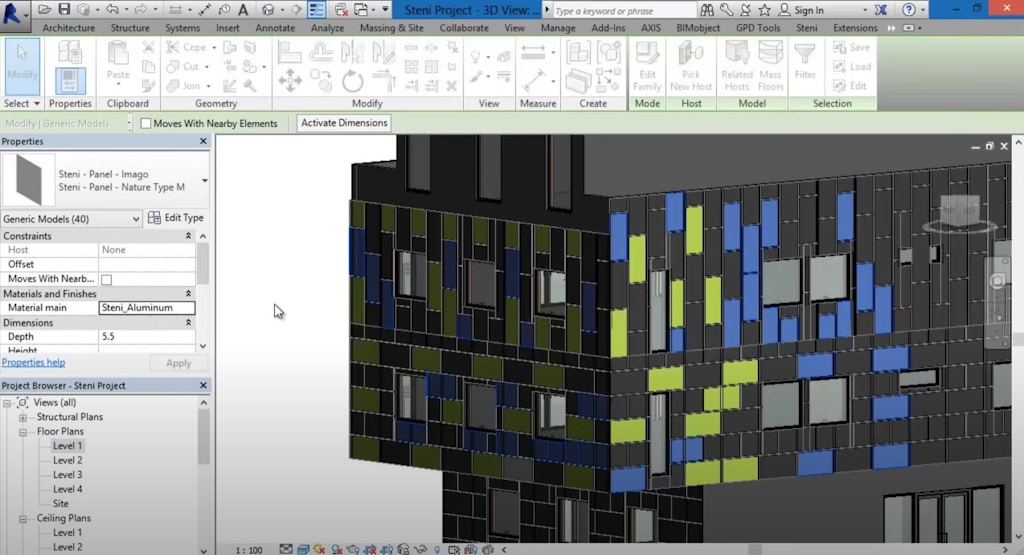Facade Technology in Educational Methodology
BIM Modeling as an Educational Tool
Presented on October 13, 2022 at Facade Tectonics 2022 World Congress
Sign in and Register
Create an Account
Overview
Abstract
With facades becoming increasingly more complex, and performance a key objective, expertise becomes an important component of successful design projects. In architectural education, the development of this technical expertise competes with many other program/curricular demands. A common solution is to add an elective course - a means to address this emerging “skill set.” Additional courses create program ‘bloat’ and force students to make a choice between departmental offerings. A possible way to address these emerging skill sets is the integration of specific façade design techniques/methodologies into studio sequences.
Resistance to adding technical facade content in studios may stem from concern of extra time required and a lack of developed methodology. Introducing technical content does not need to be time consuming; BIM modelers are already integrated into common software applications. Typical resistance to using BIM modelers is that they obstruct the design process by adding another layer of management. However, BIM modelers allow for the sharing of preconstructed technical content - a means to quickly build accurate detailed models that inform the design process in new, efficient ways. Further instruction (in our methodology) is supported with shareable, streamlined video content, reducing faculty workload.
We sample typical school curricula to understand what is typically being taught and discussed in facade technology. On this basis we look at how alternative content might be effectively and efficiently introduced into existing curricula. Using student surveys from a previous technical course focusing on facades, we identify high interest content and gain an understanding of when this content can be introduced into a program.
A sample studio component illustrates how “pre-built” rainscreen modules populating “student-designed” curtain walls can be part of a larger studio project. Using BIM modeling components to inform the façade of the project, students gain a deeper understanding of how design decisions affect building performance (common issues: moisture control, thermal bridging). High-detail digital modeling now allows students to grapple with facade constructability and details in a way that simulates physical mockups (e.g. not needing physical prototypes).
This paper proposes that the integration of enhanced BIM modeling techniques into everyday studio coursework will alleviate program ‘bloat’ and increase educational effectiveness, all the while satisfying evolving industry demands - demands for more efficient high performance systems and the processes that implement them (i.e. architectural design modeling). The variability of BIM modeling substantiates a closer look into how educational models can prove more demographically inclusive, achieved through universalized approaches to design process methodology.
Authors

Roger Schroeder
Lecturer
Alfred State College
SchroeRA@alfredstate.edu
Joseph A. Ebert
Professor
Alfred State College
jebert31@gmail.com
Keywords
Introduction and Background
The mainstream acceptance and application of rainscreen systems to the US in the early 2000s has led to increased focus on the design and expression of these facades. It is important to note the concepts and technical discussions surrounding rain screen applicability date back to research conducted in 1963 by the Canadian Research Council.1 Enhanced building performance is a subject of increasing focus within new architectural programs, as well as, the import of environmental awareness and its effects on the building system (Architecture 2030 Challenge, https://architecture2030.org/). Programs like the Architectural Ceramic Assemblies Workshop (ACAW, https://archceramicworkshop.com/) demonstrate the confluence of art and technology, while reinforcing the need to include this emerging knowledge in the education of young designers. Young designers thus provide the potential for more economically savvy firms to grow their practice - through heightened and algorithmic efficiencies. However, the key aspect of this paper is to understand current and future practices of integrated facade technology within the pedagogical realm of architectural programs in the United States.
The problematic nature of the integration of facade technology and detailing in architectural education is well-developed on such integrations into design programs (Terzich 2018). The Terzich paper explores the question of developing the “facade expert” in the architecture program, and how that may extend beyond the field of everyday practice. Our research differs by looking at developing basic facade expertise in core architectural education, to see what efficacy is enabled across traditional systems of instruction and pedagogy. The desired pedagogical outcome is an emerging architect. This figure will have an increased expertise in facade advancements, incorporating our general knowledge of the utility of BIM modeling (being more familiar with the features of the tool); this extends to the acceptance by students in a similar, developmental light, opening up the tool for exploitation as a learning platform. BIM integration into the curriculum is not without challenges (Hedges 2006): certainly there can be issues of when to introduce BIM applications into the program, at times suggesting to hold off until later, more advanced comprehensive design studios.
Increasingly, the relevancy of these ‘tooled’ applications enhances the exploratory efforts of students, while improving the design efficiencies of their technical craft. Adeptness opens up the functionality of the architecture into an interface of expressive performance - a technological taking-to-task of Venturi and Brown’s decorated shed (i.e. are architects of the technological present merely designing the cosmetic shell/billboard of a structural box?).
In our course, Advanced Structural Concepts (ASC), we introduce curtainwall systems for structural analysis, and design rainscreen elements for exploring envelope performance concepts. The course is modeling-based and in early versions of student projects, models were made of individual components (generic models). This was problematic because isolated model components rupture aspects of BIM workflow, making it difficult to implement in practice - because of each component's independent and specific applicability.
Some manufacturers have created BIM elements that detail their rainscreen components with great detail. Steni, (https://www.steni.com/) a manufacturer of a specific facade panel system, is especially well-developed and works as a plug-in for selected BIM modeling softwares. This system is an inspiration to the approach we have taken with our current research. Besides Steni, Sto is another manufacturer of the advanced software plug-ins, both of which are available on bimobject.com, a BIM resource website. After reviewing and experimenting with these plug-ins it becomes apparent that they cannot offer some of the key flexibility needed to meet pedagogical goals. Even if they did, our research still expresses apprehension toward the effective inclusion of such practices into traditional studio-based instruction.

Why do students of architecture need to see and include more facade complexity in the ‘design process’?
Parametric-based BIM components can facilitate the inclusion of rich details with minimized design time. Software and hardware improvements can efficiently manipulate these complex detail-rich models with increasingly less cost. To a certain extent, the inclusion of these details, as developed techniques, makes for a design interface that can adapt and evolve with new digital (read: software and hardware) applications that may be introduced by software developers. And where it may be true that software developers work in coordination with practitioners - to push the limits of design practice and technique - if these techniques are not introduced into the natural flow of usage, then they may never be included at all, or in the least, they will be difficult to seamlessly introduce into praxis. Providing the time and (experimental-developmental) space for students is a constructive way for students to intervene at an early stage in their own development, thereby making them not just more marketable employees, but more efficient design thinkers. Flexing these details is a means to more fluent application in the field but in a two-fold way.
The details affect the design, both visually and performatively. Rainscreen walls are very ‘thick’ by nature - in dimensionality - and transitions to glazed areas creates design challenges and opportunities for designers. Many rainscreen facade systems are panelized and require careful integration into complete wall assemblies. Their applicable success results in a wide range of design solutions: sustainability, thermal bridging, solar retention, aesthetic appeal, and mass reproducibility (accommodating the BIM process of application), to name a few. Most engaging for architecture students is aesthetics and the interchangeability and design variation of panels. Not as obvious to students is the relation of the glazing plane with respect to the cladding plane and resultant cladding returns at openings (or lack of). These all affect the appearance of the massing of the façade. That massing is best understood in rendered 3-dimensional representation facilitated with BIM modeling.
Research Questions and Methods
Will the introduction of more detailed components (specifically rainscreen) into the BIM modeling process help students better understand how function requirements of wall depth to window depth affects facade appearance
Access Restricted
Results and Discussion
The architecture program at Alfred State College prepares students to use a BIM modeler in the second semester of the program. This curtainwall assignment was the first of the semester
Access Restricted
Conclusions
From the assessments above, we have determined that practical and aesthetic successes are achievable when specific modeling applications are interwoven into the design education process. Next we need to test
Access Restricted
Rights and Permissions
References
Ambrose, Michael A. “Agent Provocateur – BIM in the Academic Design Studio.” International Journal of Architectural Computing 10, no. 1 (March 2012): 53–66. https://doi.org/10.1260/1478-0771.10.1.53.
Brenneman, Rose. 21 October, 2021. “Survey: Low-income families strained by distance learning.” USC Rossier School of Education. Accessed June 13, 2021. https://rossier.usc.edu/survey-low-income-families-strained-by-distance-learning/.
Duarte, José P. and Gabriela Celani, and Regiane Pupo. "Inserting Computational Technologies in Architectural Curricula." In Computational Design Methods and Technologies: Applications in CAD, CAM and CAE Education. edited by Gu, Ning, and Xiangyu Wang, 390-411. Hershey, PA: IGI Global, 2012. http://doi:10.4018/978-1-61350-180-1.ch022.
Esquivel, P., H. Blume, B. Poston, and J. Barajas. 13 August, 2020. “A generation left behind? Online learning cheats poor students, Times survey finds.” Los Angeles Times. Accessed June 13, 2021. https://www.latimes.com/california/story/2020-08-13/online-learning-fails-low-income-students-covid-19-left-behind-project.
Hedges, Keith. 2007 “How the Impact of Building Information Modeling (BIM) on the Cognitive Paradigm May Influence the Future of Architectural Education.” https://www.acsa-arch.org/proceedings/Annual%20Meeting%20Proceedings/ACSA.AM.95/ACSA.AM.95.67.pdf.
Jaggars, Shanna Smith. n.d. “Online Learning: Does It Help Low-Income and Underprepared Students? (Assessment of Evidence Series).” Teachers College: Community College Research Center. Accessed: June 13, 2021. https://ccrc.tc.columbia.edu/publications/online-learning-low-income-underprepared.html.
Steni, Lågendalsveien 2633, 3277 Steinsholt, Norway
Terzich, Alex. 2018 “Teaching Facades, One goal, three approaches to facade design curriculum.” Proceedings of the Facades Tectonics Institute 2018 World Congress Conference Vol 2. https://www.facadetectonics.org/papers/teaching-facades.